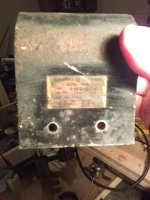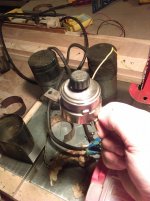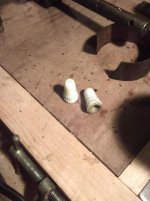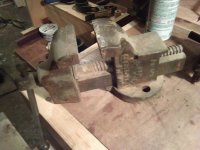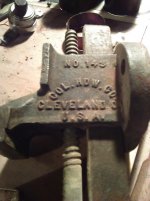OneSquareLight
Plastic
- Joined
- Jan 5, 2016
I just picked up an old bench grinder for $10 and I have not been able to find anything definitive after hours of searching online. It's an oddball for sure.
I've spent the past few nights disassembling and cleaning the crud off, hoping to uncover something that will give me a clue. The only thing I've found on the motor itself is a stamped/engraved K5. It's on the stator housing and it's very small.
I think it's a General Electric motor because the mounts for the two capacitors had stickers that read:
General Electric Capacitor
Cy 60
uF 7.5
US Pa 1850702
Schenectady NY 330V AC
The patent number is for capacitor paper from the 30's.
As I said there were two capacitors mounted to the motor.
On the sticker of each mount (same sticker referred to above) is the following:
2 1F2 12 X
and on the other...
2 1F2 12 Y
Searching turned up nothing about these capacitors.
Based on some general wiring research, I believe the motor is a 3 phase AC motor that was delta wired to run single phase. It runs on 115 when I plug it in with the slightest manual turn of the shaft. I can make it spin CW and CCW by starting it either direction. I've read that this is indicative of a 3 phase motor wired to run on single phase.
There are only 3 wires coming out of the motor. They each have small crimped brass identifiers on them. They read T1, T2, and T3.
That is about everything I know. I'm really curious about this machine. Any ideas? Here are some photos.




I've spent the past few nights disassembling and cleaning the crud off, hoping to uncover something that will give me a clue. The only thing I've found on the motor itself is a stamped/engraved K5. It's on the stator housing and it's very small.
I think it's a General Electric motor because the mounts for the two capacitors had stickers that read:
General Electric Capacitor
Cy 60
uF 7.5
US Pa 1850702
Schenectady NY 330V AC
The patent number is for capacitor paper from the 30's.
As I said there were two capacitors mounted to the motor.
On the sticker of each mount (same sticker referred to above) is the following:
2 1F2 12 X
and on the other...
2 1F2 12 Y
Searching turned up nothing about these capacitors.
Based on some general wiring research, I believe the motor is a 3 phase AC motor that was delta wired to run single phase. It runs on 115 when I plug it in with the slightest manual turn of the shaft. I can make it spin CW and CCW by starting it either direction. I've read that this is indicative of a 3 phase motor wired to run on single phase.
There are only 3 wires coming out of the motor. They each have small crimped brass identifiers on them. They read T1, T2, and T3.
That is about everything I know. I'm really curious about this machine. Any ideas? Here are some photos.







